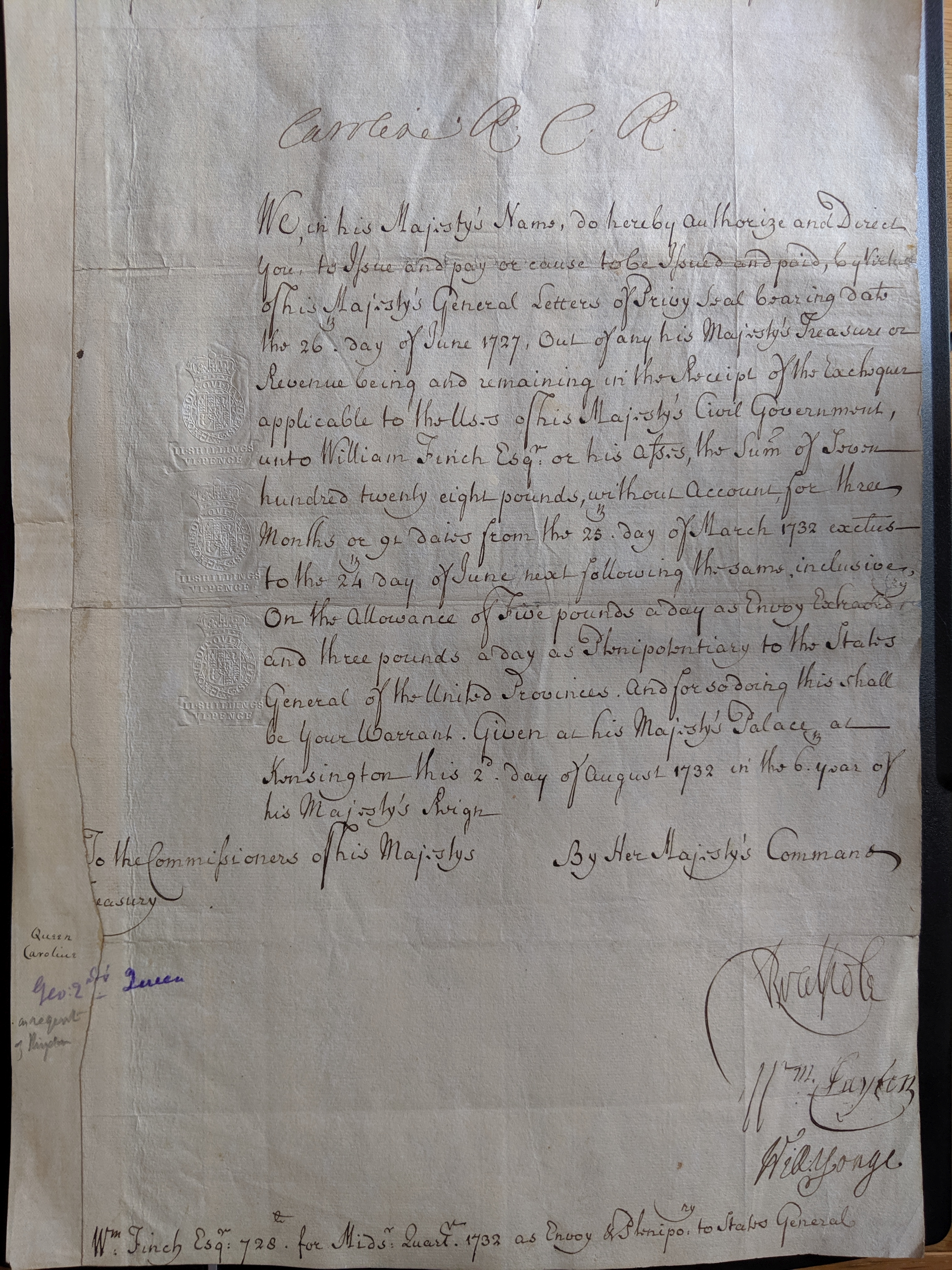
CAROLINE SIGNED AS QUEEN GUARDIAN WITH THE PRIME MINISTER
CAROLINE
(of Ansbach, 1683-1737, Queen of George II), Sir Robert WALPOLE (Sir Robert, 1st Earl of Orford, 1676-1745, 1st British Prime Minister), William CLAYTON (1671-1752, afterwards Baron Sundon, whose wife controlled much of George II's court patronage) and Sir William YONGE (4th Baronet, dc. 1693-1755, Politician, Secretary at War)
Fine Documnet signed by Queen Caroline, as Queen Guardian of the Kingdom during the absence of her husband George II ("Caroline R.C.R.")
addressed to the Commissioners of the Treasury authorising them to pay "by Virtue of his Majesty's General Letters of Privy Seal ... unto William Finch Esq or his assigns, the sum of seven hundred twenty eight pounds, without account for three months or 90 days from the 25th day of March 1732 exetus to the 24th day of June next following the same, inclusive, On the Allowance of Five pounds a day as Envoy ... and three pounds a day as Plenipotentiary to the States General of the United Provinces and for so doing this shall be your Warrant ...", 1 side folio with blind stamped duty stamps at edge, "his Majesty's Palace at Kensington", 2nd August
Caroline became queen consort on the death of her father-in-law in 1727, and she was crowned alongside her husband at Westminster Abbey. She was the first queen consort to be crowned since Anne of Denmark in 1603. The couple retained Walpole as the leading minister. Walpole secured a civil list payment of £100,000 a year for Caroline, and she was given both Somerset House and Richmond Lodge. Caroline had immense influence. She persuaded the King to adopt policies at the behest of Walpole, and persuaded Walpole against taking inflammatory actions.
Over the next few years, she and her husband fought a constant battle against their eldest son, Frederick, Prince of Wales, who had been left behind in Germany when they came to England. He joined the family in 1728, by which time he was an adult, had mistresses and debts, and was fond of gambling and practical jokes. He opposed his father's political beliefs, and complained of his lack of influence in government. The Regency Act of 1728 made Caroline rather than Frederick regent when her husband was absent on four separate occasions.
Walpole, usually described as Britain's first prime minister, attributed much of his success to the influence of Queen Caroline. On the accession of George II in 1727, it had been widely expected that Walpole, whom the new king disliked, would be turned out of office in favour of his rival Sir Spencer Compton. In his characteristically coarse way, Walpole is said to have attributed his success to the fact that Compton 'took the wrong sow by the ear... I the right', Compton having paid court to Henrietta Howard, whereas Walpole had recognized that George paid far more attention to his wife than to his mistress. As one lampoon had it: 'You may strut, dapper George, but 'twill all be in vain;/ We know 'tis Queen Caroline, not you, that reign'. Indeed, during the Excise Bill riots the following year it was the Queen, rather than her husband, who was to be burned in effigy alongside Walpole (Stephen Taylor, ODNB).
William FINCH(1691-1766) was a British diplomat and Whig politician who sat in the House of Commons from 1727 to 1761. He was considered an indolent diplomat and became an opponent of Walpole, but maintained his post in the Royal Household for over 20 years until he began to lose his senses. He was Envoy Extrordinary and Minister Plenipotentiary to the United Provinces from 1733-1734.
Item Date:
1732
Stock No:
40173

<< Back